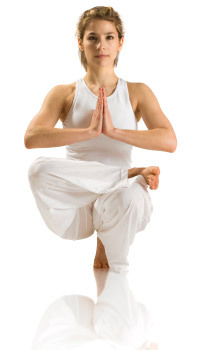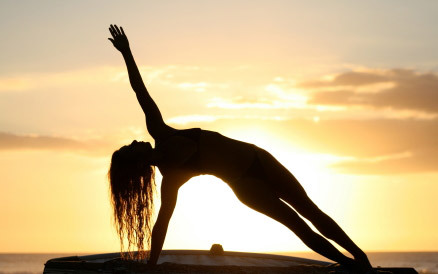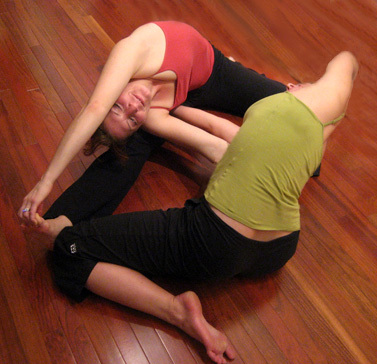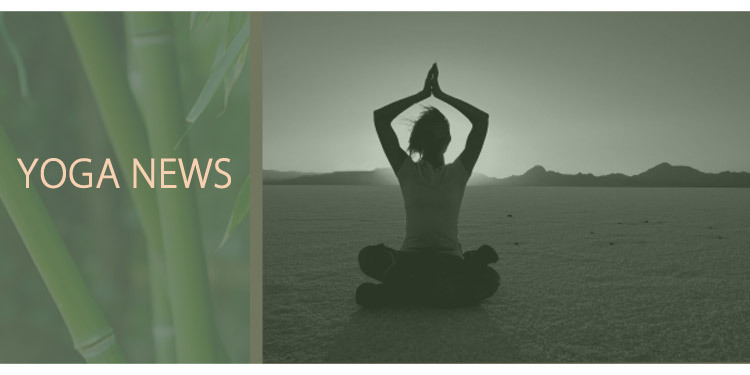 |
 |
 It's
truly baffling how many different types of yoga are practiced throughout the
world. Although most types of yoga utilize the same poses, there are some major
differences between what they each aim to accomplish. Here is a quick overview
of some of the yoga styles. Keep in mind there are many more which aren't
listed here. It's
truly baffling how many different types of yoga are practiced throughout the
world. Although most types of yoga utilize the same poses, there are some major
differences between what they each aim to accomplish. Here is a quick overview
of some of the yoga styles. Keep in mind there are many more which aren't
listed here.
Hatha Yoga - is the most commonly practiced style of yoga. In fact, it is
the foundation of all other styles. Hatha incorporates asanas (postures),
pranayama (regulated breathing), dharana & dhyana (meditation), and
kundalini (Laya yoga) into a complete system that can be used as a source of
exercise and stress management. Hatha poses should be approached with a calm,
meditative mindset. The goal is to become inwardly aware as the body performs
the series of poses selected for the practice session.
Ashtanga (or Astanga) Yoga - is an athletic yoga practice that is
physically demanding as it involves synchronizing breathing with a progressive
and continuous series of postures. The process produces a purifying sweat that
detoxifies muscles and organs.
Bikram Yoga/ Hot Yoga - is a comprehensive workout that includes all the
components of fitness: strength, endurance, flexibility, and weight loss.
Bikram is typically practiced in an environment with a temperature of 95-105
degrees. The heat promotes flexibility, detoxification, and prevention of
injuries.
Vinyasa - a very physically active
form of yoga that focuses on coordination of breath and movement.
Kundalini Yoga - focuses on awakening the energy at the base of the
spine and drawing it upward. In addition to postures, a typical Kundalini
practice might include chanting, meditation, and breathing exercises.
Integral Yoga - combines postures, breathing exercises, meditation,
chanting, prayer, selfless service, and self-inquiry.
Ananda Yoga - focuses on proper body
alignment, controlled breathing, and gentle postures designed to move energy up
to the brain and prepare the body for meditation.
Iyengar Yoga - promotes strength, endurance, flexibility, and balance
through coordinated breathing and poses that require precise body alignment. In
Iyengar, you slowly move into a pose, hold it for a minute or so, and then rest
for a few breaths. Although Iyengar incorporates the traditional postures that
make up the broader realm of Hatha yoga, the cushions, blankets, straps, and
blocks used in this style have revolutionized yoga by enabling everyone - even
the elderly, sick, and disabled - to practice.
Power Yoga - is the American interpretation of Ashtanga yoga, a discipline
that combines stretching, strength training, and meditative breathing. Many of
the poses resemble basic calisthenics -- push-ups, handstands, toe touches, and
side bends -- but the key to power yoga's sweat-producing, muscle-building
power is the pace. Each move flows into the next without pause, making this
variety of yoga an intense aerobic workout.
Jivamukti Yoga - expresses the spiritual and ethical aspects of the
practice of yoga that have been disregarded or devalued in contemporary times.
It is a vigorous and challenging asana form that emphasizes scriptural study,
Sanskrit chanting, vegetarianism, non-violence, meditation, devotion to God,
and the role that music and listening play in the practice of yoga.
Viniyoga - is commonly used as a therapeutic practice for people who have
suffered injuries or are recovering from surgery. It is a gentle, healing
practice that is tailored to each person's body type and needs as they grow and
change.
Svaroopa Yoga - promotes healing and
transformation. New students find this to be an approachable style of yoga, as
practice often begins in comfortable chair poses.
Kripalu Yoga - is considered the yoga of consciousness. This gentle,
introspective practice urges practitioners to hold poses to explore and release
emotional and spiritual blockages. Goal-oriented striving is discouraged and
precise alignment is not as important as in some other traditions.
Sivananda Yoga - combines postures, breathing, dietary restrictions,
chanting, scriptural study, and meditation--similar to Integral yoga.
|
|
 |
 |
|

Bikram
yoga, or hot yoga, is a series of poses done in a room which is usually heated
to a temperature of 105 degrees Fahrenheit. A vigorous yoga session at this
temperature promotes copious sweating, which purifies and rids the body of
toxins. It also makes the body very warm, and therefore more flexible. The
heated studio facilitates deeper stretching, prevents injury, relieves tension,
and detoxifies the body.
Bikram yoga is a system of wellness, restoration and rejuvenation. It was
designed to stimulate and restore health to every muscle, joint and organ in
the body. Participants are guided through a series of 26 postures in which both
the breathing (pranayama) and the postures (asana) rely on each other to
deliver positive results. According to Bikram Choudhury, founder of hot yoga and
the Bikram Yoga College of India in Los Angeles, many people only use up to 50%
of their lung capacity, and just like any muscle, the lungs must be stretched
and with time will be able to hold more oxygen. By practicing the pranayama you
will eventually be able to enhance oxygen conversion and absorption, as well as
improve blood circulation.
Because of two processes called extension and compression, blood circulation is
affected immensely during Bikram yoga. These two dynamics work together to
deliver fresh oxygen to every joint, muscle, and organ in body. While
performing a specific asana, the body is stretching or compressing a certain
part of the body, thus restricting circulation and causing the heart to pump
more blood to the area. The pumping of excess fresh blood is called extension.
Once the asana is complete, the newly oxygenated blood rejuvenates the arteries
that were being compressed. It is said that because of the volume change and
influx of fresh blood, any infection, bacteria, or toxin can be released during
a Bikram yoga practice.
|
|
Learn more about Bikram yoga...
|
|
 |
 |
 Relationships can be
the greatest source of happiness--and the greatest source of tension--in your
life. Whenever you choose to share your mind, heart, and perhaps your body with
another human being, you will encounter expectations, fears, and conflicts.
Yet, in a yoga of love, each of these offers you a step towards fulfillment. Relationships can be
the greatest source of happiness--and the greatest source of tension--in your
life. Whenever you choose to share your mind, heart, and perhaps your body with
another human being, you will encounter expectations, fears, and conflicts.
Yet, in a yoga of love, each of these offers you a step towards fulfillment.
Yoga can actually help improve relationship habits and emotional patterns.
Relationship concepts are implicit in the art of yoga. Enlightenment usually
refers to transcending suffering and desire. In a yoga of relationships,
fulfillment may be better described as tapping into the deep, multi-dimensional
happiness available to you. In this case, the goal of fulfillment or shared
happiness is attained through reactions, shared love, and thoughtfulness.
Are your relationships in a romantic stage, a power struggle, or a crisis? Yoga
for two might just be the soul work you need to help you through your
struggles, heal your wounds, and set you both on the path of expressing and
receiving the love you want to share. Try some partner yoga exercises which use
the buddy system to dissolve tension and establish a natural state of harmony
in body, mind, emotion, and spirit.
In partner yoga, much attention is given to the importance of intimacy and
touch. Touch is seen as a basic human need which, in the modern world, goes
largely unsatisfied. Partner yoga offers a system that treats touch and
intimacy as integral parts of our mental, emotional, and physical well-being.
In poses and exercises, partners rely on each other's support to maintain
proper body alignment, balance, and concentration. In a deeper sense, this
physical support fosters deeper feelings of nurturing, acceptance, and trust.
When you feel safe and supported you develop the courage to confront your fears
and embrace your true self.
|
|
Watch video demonstrations of partner yoga poses...
|
|
 |
 |
Q: What is yoga?
A: The word yoga means union in
Sanskrit, the language of ancient India where yoga originated. We can think of
the union occurring between the mind, body and spirit.
What is commonly referred to as yoga can be more accurately described by the
Sanskrit word asana, which refers to
the physical postures you perform during practice. In the West, the words asana and yoga are often used interchangeably. Asana is only one of the eight
"limbs" of yoga, the majority of which are more concerned with mental
and spiritual well-being than physical activity.
Q: How do I choose a style of yoga?
A: If you are brand new to yoga, you
may want to take a few Hatha classes to learn the basic poses. However, Hatha
is usually slow paced, so if you are the kind of person who likes to move
around more, you might choose a style that's more physically demanding. Even if
you are already in great shape, take a few beginner's classes to learn the
poses and avoid the risk of injury. And while there are many great yoga books
and videos available, there is no substitute for learning directly from a good
teacher who specializes in the style(s) of yoga you wish to practice.
Q: What kind of equipment do I need?
Clothes: Comfortable, breathable clothes are recommended for yoga. You probably
want to wear a shirt that is a little bit form-fitting, since your shirt can
slide down in some of the poses. Any exercise pants or shorts will do, although
it's best not to wear slick pants that may cause you to slip.
Shoes: No shoes required. All you need are your bare feet!
Mats: Your yoga mat helps define your personal space, but more importantly, it
creates traction for your hands and feet so you don't slip. Your mat also
provides a bit of cushioning on a hard floor. Most studios have mats for
students to borrow or rent, just be sure to bring a mat cleaning solution so
you can spray it down before and after use. If you prefer to have your own,
they can be purchased for as little as $20.
Optional Equipment
Blankets: Yoga studios often have stacks of blankets available for students to
use during class. Grab yourself one or two blankets at the beginning of class.
The blankets can be used as props to sit on or lie on. They come in handy for
all sorts of things during a practice, and if it's chilly you can use one as a
cover during relaxation at the end of class.
Blocks: Blocks can be used to make yourself more comfortable and improve your
alignment. They're great for standing poses in which your hands don't reach the
floor.
Straps: Straps are particularly useful for bound poses if your hands do not
reach each other, and for poses where you need to hold onto your feet but
cannot reach them.
|
|
Check out a Beginner
|
|
 |
Movements Yoga Studio
Mary Bright - Owner
888-232-yoga
|
|
|
 |
|
In This Issue
|
|
 |
|
Updates from the studio
|
|
Movements Yoga Studio
Mary Bright - Owner
888-232-yoga
|

|
|
Quick, but Effective Yoga
|
Even
a short yoga practice can be relaxing and invigorating. Yoga can improve
posture and blood flow to the body's organs and tissues. Here are some
guidelines for setting up a quick yoga workout, for those times when your
schedule doesn't allow you to commit to a lengthier practice.
Step 1 - Set aside ten to twenty minutes a day when you can take time for
yourself without any distractions.
Step 2 - Clear a space and gather what you need. Play some soft music. Focus on
your breathing, fluid body movements, and a clear mind.
Step 3 - Stretch and warm up before you begin. Roll your shoulders and rotate
your neck. Do a cat stretch by getting on all fours and slowly rounding your
back.
Step 4 - Perform the downward dog. Get down on your hands and knees. Keep your
feet and hands on the ground while pushing your hips up to form an inverted V.
Step 5 - To get the full benefit of a short yoga workout, try to perform at
least one pose for each major muscle group. Some suggestions are: the locust,
the half-moon, and the pigeon -- but you can customize your series as you wish.
Step 6 - Perform poses that flow naturally from one to another. For example, do
standing poses first, then move on to sitting poses and inversions. This will
help your practice flow quickly and smoothly.
Step 7 - Your breathing should be slow and controlled during your quick yoga
workout. Fill your lungs completely when you inhale, and exhale slowly through
your nose.
|

|
|
Featured Product: Yoga in the Car
|
Stuck
in traffic? Why not do some yoga! Yoga in
the Car (Bumper to Bumper edition) with Jen Swain is the first CD of its
kind to guide commuters through yoga poses while sitting in the car.
Bumper to Bumper is a 13-track CD with a very simple breathing and movement
exercise series that can be done while you are sitting in traffic. Starting
with an introduction to breath, this particular form of yoga uses a combination
of focus and subtle movements to help release tension and wake up potential
energy. Jen guides commuters through exercises designed to open those areas
that get the most aggravated by sitting for too long: the neck, shoulders,
back, and hips. This is yoga for EVERYBODY.
Learn more
about Yoga in the Car...

|
|
 |




